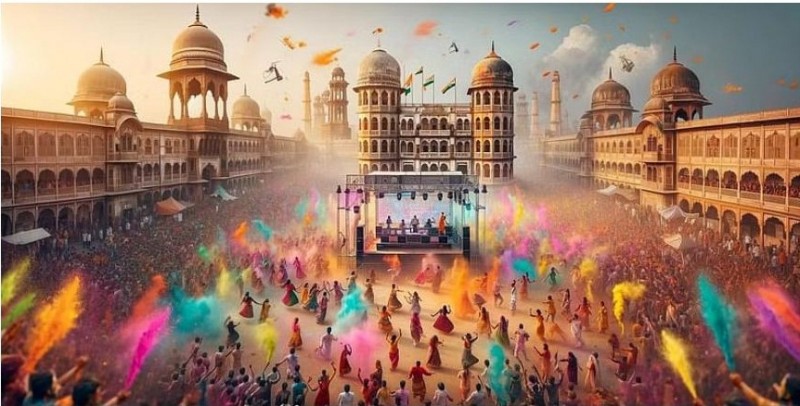
As the vibrant festival of colors, Holi, approaches, India gears up for a celebration that transcends boundaries of age, religion, and region. While the essence of Holi remains consistent throughout the country – a jubilant occasion marked by the splashing of colors, joyous gatherings, and delectable treats – the customs and traditions associated with it vary significantly from one region to another. In 2024, let's delve into the kaleidoscope of Holi celebrations across India, discovering the unique customs that make each region's festivities a colorful tapestry of cultural richness.
North India: The Heartland of Holi
In the northern states of India, particularly Uttar Pradesh, Bihar, and Delhi, Holi is celebrated with unparalleled fervor and exuberance. Here, the festivities commence with Holika Dahan, a ritualistic bonfire commemorating the triumph of good over evil. People gather around the bonfire, sing devotional songs, and perform prayers, symbolizing the victory of righteousness. The next day, streets come alive with vibrant hues as people drench each other in colored powders and water, exchanging sweets and warm wishes. Traditional delicacies like gujiya, dahi vada, and thandai add flavor to the celebrations, fostering a sense of communal harmony and joy.
West Bengal: Basanta Utsav – Holi with a Cultural Twist
In West Bengal, Holi is celebrated as Basanta Utsav, an integral part of the state's rich cultural heritage. Spearheaded by the iconic poet Rabindranath Tagore, Basanta Utsav transcends traditional Holi revelries to embrace the spirit of spring and rejuvenation. Clad in vibrant yellow attire, reminiscent of the blooming mustard fields, people gather at Shantiniketan to partake in cultural performances, including dance, music, and poetry recitations. The air is filled with melodies of Rabindra Sangeet, adding a soulful dimension to the festivities. Basanta Utsav exemplifies the fusion of art, literature, and spirituality, reflecting Bengal's artistic legacy and progressive ethos.
South India: Holi – A Subdued Affair with a Touch of Tradition
In the southern states of India, such as Tamil Nadu, Karnataka, and Kerala, Holi assumes a more subdued yet culturally rich demeanor. Known as Kamavilas, the festival is celebrated with a blend of regional customs and rituals. While the fervent color-play may not be as prevalent as in the North, people engage in unique traditions such as offering prayers to Kamadeva, the god of love, and lighting lamps to ward off evil spirits. In Tamil Nadu, Holi coincides with the Tamil New Year, adding an extra layer of significance to the celebrations. Families come together to prepare special delicacies like holige (sweet flatbread) and savories, fostering bonds of love and unity.
Gujarat: Rangoli and Raas – A Cultural Extravaganza
In Gujarat, Holi is synonymous with the exuberant festival of Navratri. The festivities kick off with a grand procession featuring traditional folk dances like Garba and Dandiya Raas, accompanied by rhythmic beats of dhol. The streets are adorned with vibrant rangolis, depicting intricate patterns and motifs, symbolizing prosperity and auspiciousness. Unlike the boisterous water fights, Holi in Gujarat revolves around the cultural performances and community gatherings, where people revel in the spirit of togetherness and merriment. The air resonates with chants of "Holi hai!" as people immerse themselves in the joyous ambiance.
Northeast India: Phakuwah – A Blend of Tradition and Tribal Customs
In the northeastern states of India, Holi is celebrated with a unique blend of tradition and tribal customs. Known as Phakuwah in Assam, the festival is characterized by vibrant processions, folk dances, and traditional music performances. People smear each other with natural colors derived from turmeric and other herbs, adding a distinct aroma to the festivities. In Manipur, Holi coincides with the festival of Yaosang, marked by community feasts, folk dances like Thabal Chongba, and the burning of thatched huts symbolizing the triumph of good over evil. Holi in the Northeast epitomizes the region's cultural diversity and harmonious coexistence.
Celebrating Unity in Diversity
As we embark on a journey through the regional Holi traditions of India in 2024, we are reminded of the country's cultural tapestry, woven with threads of diversity and unity. Despite the regional variations, the essence of Holi – spreading joy, fostering camaraderie, and embracing the spirit of renewal – remains unchanged. Whether it's the spirited revelries of North India, the artistic fervor of West Bengal, or the cultural amalgamation of Gujarat, Holi transcends geographical boundaries to unite people in a kaleidoscope of colors and traditions. As we immerse ourselves in the jubilant festivities, let's celebrate the rich heritage of India, where every color tells a story, and every tradition reflects the vibrancy of life itself.
So, this Holi, let's not just play with colors but also embrace the cultural hues that make India truly incredible. Happy Holi!